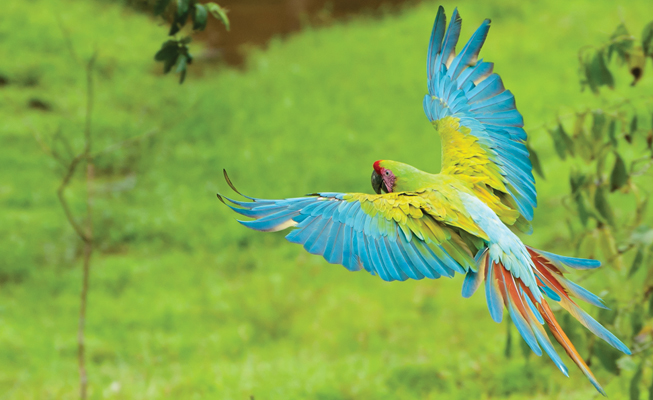Message from the Executive Director
“This is one of the most successful wildlife conservation efforts ever done in Costa Rica. We feel proud in bringing from the brink of extinction this beautiful species.”
CEPF grantees build local capacity, collaboration and a future for the great green macaw
Even people who do not have the faintest interest in birds are likely to be impressed by the great green macaw (Ara ambiguus)—its 85–90 cm long green-and-blue body is highlighted by bright red patches on the forehead and tail. Its beauty has contributed to the macaw’s unfortunate popularity in the illegal pet trade. But a bigger problem for the species, which is categorized as Endangered on the IUCN Red List of Endangered Species, has been the loss of its natural habitat.

This spectacular bird species is part of the vibrant ecosystems of lowland tropical rainforests in Central and South America. But logging and clearance for agriculture and ranching have reduced the macaw’s distribution range. The great green macaw particularly relies on mountain almond trees (Dipteryx panamensis) for nesting and food, but these unique trees are disappearing due to their high value as commercial hardwood.
Taking action
In Costa Rica, the organization Tropical Science Center (TSC) was launched in 1994 to study the conservation biology of the great green macaw. Preliminary results provided evidence that the nesting range of this species in Costa Rica had been reduced by 90 percent since the early 20th century. TSC studied the macaw and its habitat, about which little was known, and used radio telemetry to compile basic data on its territory requirements.
In 1998, after receiving a request from the Ministry of Environment and working with local and national stakeholders, TSC proposed a plan to protect enough habitat to maintain a viable breeding population in Costa Rica. The plan included the creation of the Maquenque National Wildlife Refuge, 54,000 hectares of natural ecosystems that provide an ad hoc breeding habitat for the great green macaw.
This is where CEPF stepped in. Through CEPF’s investment in the Mesoamerica Biodiversity Hotspot, which began in 2002, it sought to protect Maquenque as part of the conservation strategy CEPF developed with local stakeholders and with the support of the Costa Rican government. CEPF provided funds to TSC and the San Juan–La Selva Council, a consortium of organizations including TSC, to take the necessary steps toward establishing the reserve. Those steps included a land tenure study, development of a management plan and an education campaign. In doing this, not only were local organizations able to collaborate with government officials to eventually reach their goal of formal protection for this area in 2005, but they were also able to strengthen their own organizations and partnerships.
Lasting benefits for people and nature
Today, the legacy of these achievements is evident. Maquenque National Wildlife Refuge is the core of the San Juan–La Selva Biological Corridor and conserves biologically diverse forest and wetland ecosystems that host more than 6,000 species of vascular plants, as well as 139 mammal, 515 bird, 135 reptile and 80 amphibian species. Among the residents of the area is a growing population of great green macaws. Recent studies by TSC show that the population has increased from 210 in 1994 to more than 350 individuals, including 50 breeding pairs—a number that is steadily climbing.
“Thanks in great part to the support of CEPF, Costa Rica has succeeded in restricting timber activities in the critical nesting area of the great green macaw as well as halting the unsustainable harvest of the mountain almond tree on which this species heavily depends,” said Olivier Chassot, former executive director of TSC, who is now executive director and chief executive officer of the organization MigraMar.
Communities are also benefiting from these conservation efforts. To promote sustainable development and conservation in the northern part of Costa Rica, the Costa Rican government provided incentives to local farmers and communities to encourage their support for reforestation with native tree species that are both commercially important and of benefit to the great green macaw. Consequently, a high percentage of Maquenque and of the biological corridor is conserved through environmental service payments to private landowners.
The San Juan–La Selva Council also has worked to generate employment opportunities in the area, which was previously economically depressed. A shift from limited forestry and agricultural activities to a more integrative socio-economic vision based on small-scale, nature-based tourism has fostered more long-term and sustainable employment.
Years of environmental education, capacity building, information campaigns and cultural events have led communities to an empathy for the plight of the great green macaw, according to Chassot.
Additionally, the direct and active participation of the communities in research and conservation has further encouraged residents to get their voices heard on matters affecting their environment.
“This is one of the most successful wildlife conservation efforts ever done in Costa Rica,” said Carlos Manuel Rodríguez, minister of environment of Costa Rica. “We feel proud in bringing from the brink of extinction this beautiful species.”
The amount of money CEPF provided for projects related to Maquenque was modest—US$217,000 in total. But what CEPF grantees have been able to achieve with that support is testimony to the power that lies in a strong local civil society. CEPF’s funding served as a catalytic contribution to the efforts of local conservation leaders, who have successfully demonstrated that nature in all its magnificent diversity can thrive while supporting communities.
– Olivier Langrand,
CEPF executive director
Photo Credits
Olivier Langrand. © Nicholas Karlin
A great green macaw takes flight in Costa Rica. © Ralph Earlandson/Flickr Creative Commons


